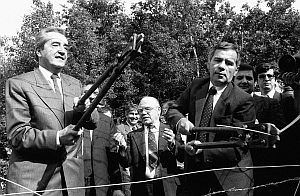The scientific symposium “Hungary between Times and Worlds” from April 30 to May 2 will cover topics in the fields of politics, society, and culture of Hungary. This international symposium will be organized by ZAK I Center for Cultural and General Studies of KIT on the occasion of the 2010 European Culture Days in Karlsruhe. ZAK cooperates with the Karlsruhe Chamber of Industry and Commerce, the ZKM I Center for Art and Media Karlsruhe, the Karlsruhe Baden State Theater, and the City of Karlsruhe.
Journalists are cordially invited. Kindly register at s heneka-peters ∂does-not-exist.zak kit edu or by phone +49 (0) 721 608 8027. The venue will be the Chamber of Industry and Commerce, Karlsruhe, Saal Baden, Lammstraße 13-17.
On Friday, April 30, the international symposium will be opened by a reception for the photo exhibition “Freedom and Democracy - Hungary – From the Fall of the Iron Curtain to Joining the Schengen States”. The exhibition will focus on the events relating to the pan-European picnic on August 19, 1989, during which hundreds of GDR citizens fled from Hungary across the border. The process of political liberation will then be dealt with by the Hungarian writer and historian György Dalos in his presentation from 19 hrs. Dalos is living in Berlin and was recently awarded the 2010 Leipzig Book Award for European understanding.
After this, a podium discussion at 20 hrs will cover the status of current Hungarian democracy. Hungarian scientists and politicians – Professor Máté Szabó (Parliamentarian Ombudsman for Civil Rights, Hungary), Professor György Schöpflin (Member of the European Parliament), Professor Ferenc Miszlivetz (Institute for Social and European Studies, Hungary), and Professor Ellen Bos (Andrássy Gyula German-speaking University of Budapest) – will discuss causes and solutions of the present crisis of democracy.
Presentations Relating to Hungary’s European
Policy Agenda
On Saturday, May 1, from 9.30 hrs, the economic crisis in Hungary will be discussed. Professor Martina Eckardt (Andrássy Gyula German-speaking University of Budapest) will talk about possible causes of the economic crisis in Hungary. Dr. Noémi Alexa from Transparency International Hungary will speak about “Transparency Measures against Corruption in Hungary”. The regaining of strength of far-right ideologies during the political and economic crisis is the subject of the presentations by Professor Gáspar Miklós Tamás (philosopher) and Dr. András Tóth (Hungarian Academy of Sciences). Dr. Ernö Kállai, Parliamentarian Ombudsman for Ethic and National Minorities, and Professor Katalin R. Forray (University of Pécs) will then talk about the alarming situation of the Roma minority in Hungary and about social and (education) policy measures for its integration. Hungary’s European policy agenda – the country will take over the presidency of the EU council in the first half year of 2011 – will be the subject of the presentation by Professor Attila Àgh (Corvinus University of Budapest).
Contemporary Witnesses at the Final Podium Discussion
Sunday, May 2, will focus on contemporary art in Budapest and its possibilities of influencing the political and social development. This topic will be discussed from 11 hrs by Dr. Mária Meyer-Szilágyi (Contemporary Drama Festival Budapest) and the artist Alexander Schikowski.
The symposium will be completed on Sunday afternoon, 13.30 hrs, by a podium discussion on Hungary’s role in overcoming the division of Europe. Scientists and German and Hungarian contemporary witnesses will discuss the significance of the “first crack” of the iron curtain.
Being “The Research University in the Helmholtz Association”, KIT creates and imparts knowledge for the society and the environment. It is the objective to make significant contributions to the global challenges in the fields of energy, mobility, and information. For this, about 10,000 employees cooperate in a broad range of disciplines in natural sciences, engineering sciences, economics, and the humanities and social sciences. KIT prepares its 22,800 students for responsible tasks in society, industry, and science by offering research-based study programs. Innovation efforts at KIT build a bridge between important scientific findings and their application for the benefit of society, economic prosperity, and the preservation of our natural basis of life. KIT is one of the German universities of excellence.

